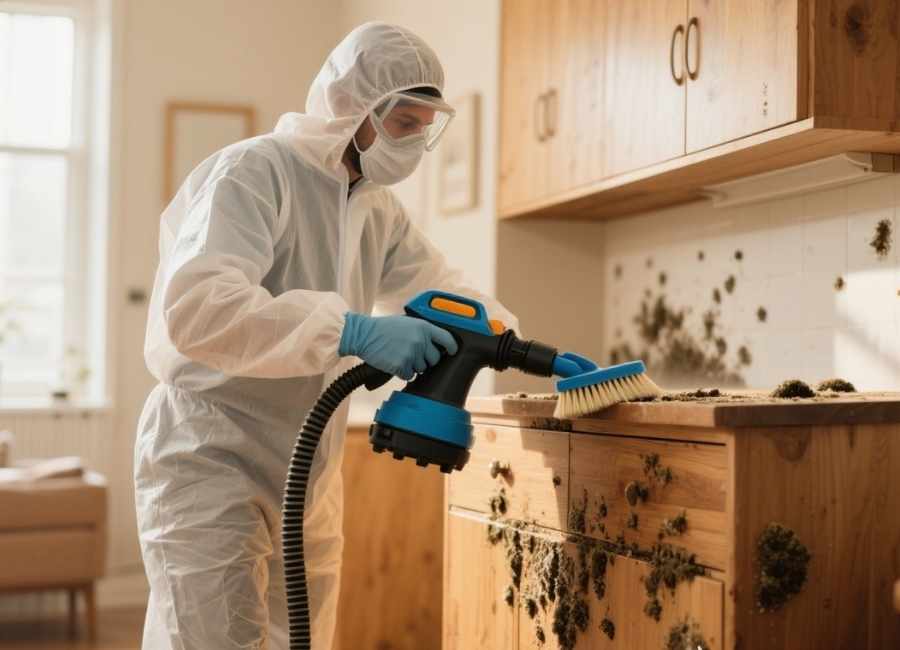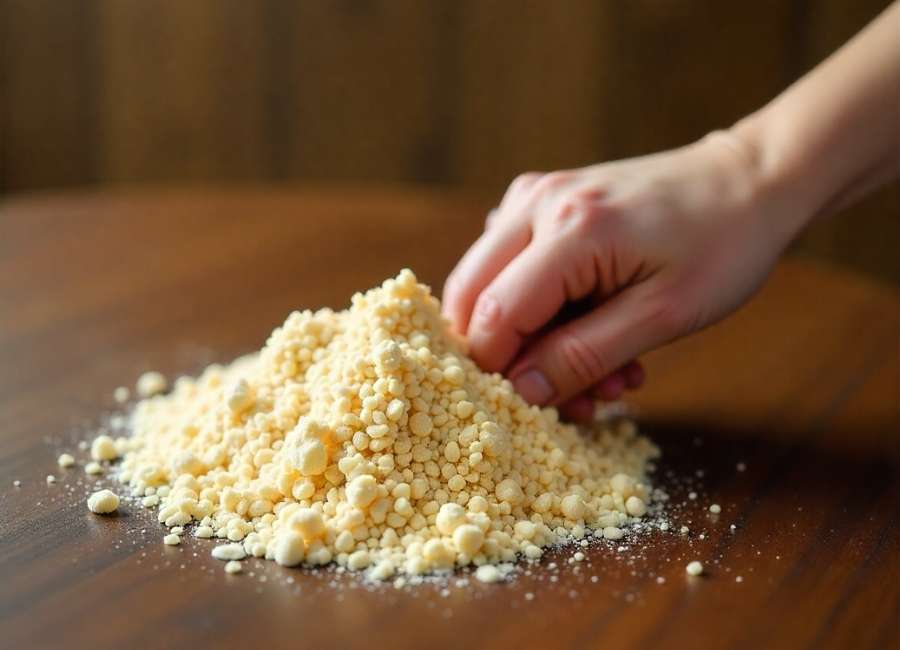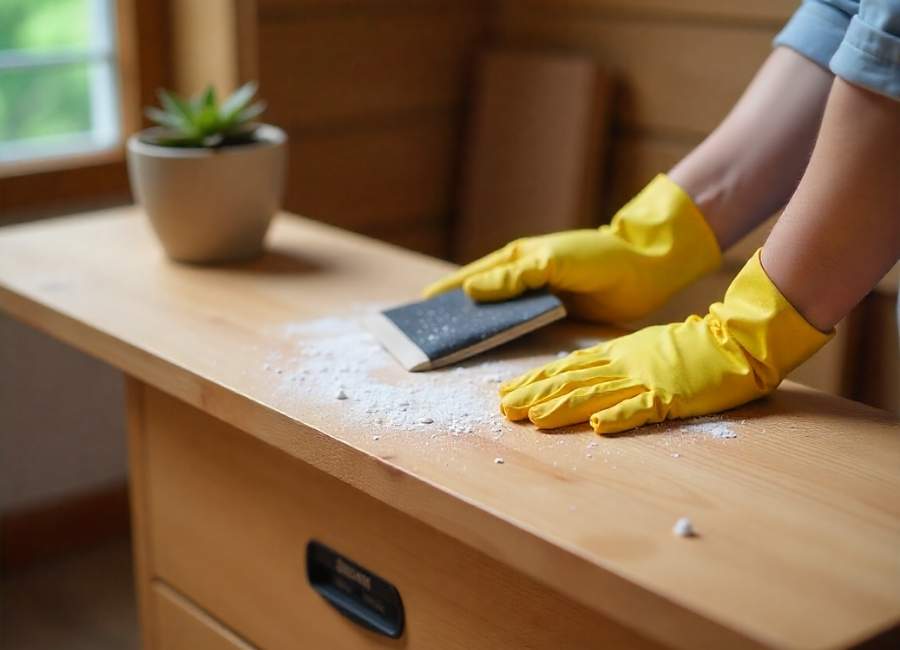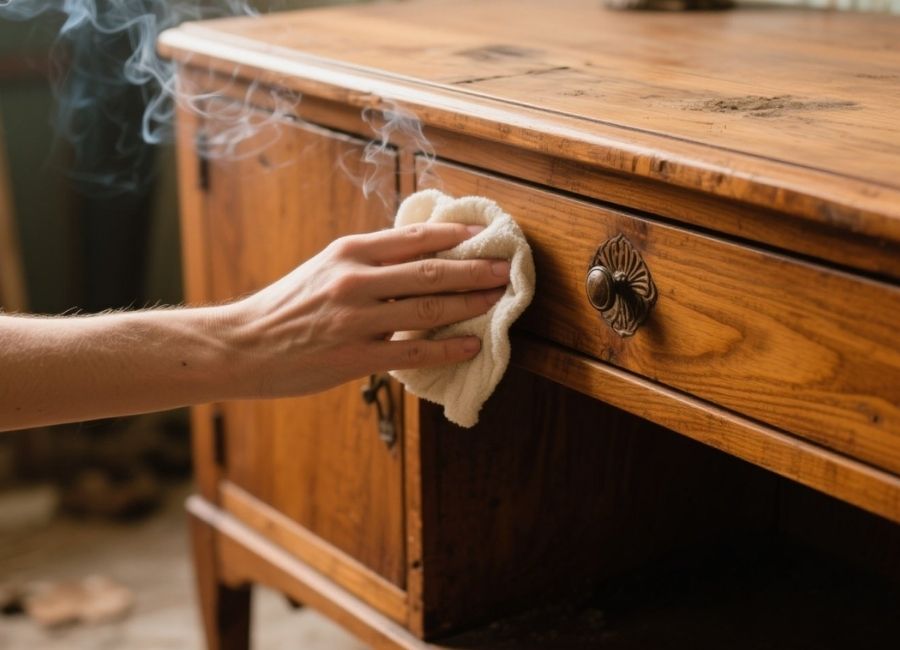Found a great piece of wood furniture, but it comes with a smell you can’t ignore. Whether it’s a musty odor from sitting in a basement or the lingering scent of smoke, unwanted smells can ruin an otherwise perfect item.
This guide offers simple and effective methods for removing those odors. We will walk you through several techniques using common household items. You will learn how to clean furniture, absorb odors, and seal wood to prevent future issues. By following these steps, you can restore your furniture and make it a welcome addition to your home.
Clean the Furniture Thoroughly

Before you can deodorize, you need to clean. Dirt, grime, and mold spores are often the sources of unpleasant odors. A deep cleaning is the essential first step to fresh-smelling furniture.
Initial Cleaning
Start with a gentle but effective cleaning solution.
- Mix a solution of mild soap (like dish soap) and warm water.
- Dampen a soft cloth with the soapy water, making sure to wring it out well. You want the cloth damp, not dripping wet, as excess moisture can damage the wood.
- Wipe down all surfaces of the furniture, both inside and out. Pay special attention to corners, drawers, and other hidden areas where dust and grime tend to accumulate.
- Rinse with a clean, damp cloth to remove any remaining soap residue.
- Dry completely with a clean, dry towel. Do not let water sit on the wood.
For Tougher Jobs: Vinegar Solution
If the musty smell persists, you may be dealing with mold or mildew. A vinegar solution is a powerful, natural disinfectant. (Umpire’s Practical Odor Removal + Disinfection Guide for Homeowners, n.d.)
- Create a mixture of equal parts white vinegar and water.
- Apply the solution with a soft cloth, again ensuring it’s not overly wet.
- Wipe all surfaces thoroughly. The vinegar will kill mold and mildew spores that cause odors. (Does Vinegar Kill Mold? (DIY Spray Instructions), n.d.)
- Air it out. The smell of vinegar will be strong at first, but it will disappear as the furniture dries, taking other odors with it.
After cleaning, let the furniture air dry completely, preferably outdoors in a shaded, well-ventilated area. Direct sunlight can cause the wood to warp or fade, so avoid placing it in the sun for extended periods.
Use Absorbents to Soak Up Odors

After a thorough cleaning, some smells might still linger deep within the wood. The next step is to use natural absorbents to draw out these stubborn odors. This process is simple and requires items you likely already have.
Baking Soda
Baking soda is a classic deodorizer that works by absorbing and neutralizing smells. (Effective Ways To Remove Odors From Wood Furniture: Natural Tips & Professional Solutions, n.d.)
- Sprinkle a generous layer of baking soda inside drawers, on shelves, and over upholstered sections if applicable.
- Place open bowls or boxes of baking soda inside larger cabinets or compartments.
- Leave it for at least 24 hours. For strong odors, you may need to let it sit for several days to allow the scent to dissipate.
- Vacuum the baking soda off the furniture. Use a brush attachment to avoid scratching the wood.
Activated Charcoal
Activated charcoal is even more porous than baking soda, making it highly effective at trapping odor molecules. (Can you use activated charcoal as a room deodorizer?, n.d.)
- Place charcoal briquettes (the kind without lighter fluid) in several small, open containers or wrap them in breathable fabric, such as cheesecloth.
- Set the containers inside drawers and cabinets.
- Close the doors and drawers to let the charcoal work its magic for a few days.
- Dispose of the charcoal once the smell is gone.
Coffee Grounds and Kitty Litter
Other common household items can also serve as powerful deodorizers.
- Coffee Grounds: Place dry, unused coffee grounds in bowls inside the furniture. They will absorb odors and leave a pleasant coffee scent, which will fade over time.
- Kitty Litter: Unused, clean kitty litter is designed to absorb moisture and odors. (Will Kitty Litter Absorb Smells? The Surprising Deodorizing Power of Cat Litter, n.d.) Fill a shallow pan with it and place it inside the furniture for a few days.
Choose one of these methods and be patient. It can take some time for the absorbent material to fully pull the unwanted smells from the wood.
Seal the Wood

If you’ve cleaned and deodorized your furniture and a faint smell still remains, the odor may be trapped deep in the wood’s grain. In this case, sealing the wood is the best way to lock in any remaining smells and prevent them from returning.
Sealing is particularly effective for persistent smoke smells or strong musty odors that cleaning alone can’t eliminate.
Choose Your Sealer
You need a product that creates a barrier over the wood.
- Shellac-based primers are excellent for blocking stains and odors. They dry quickly and are very effective. (How Long for Primer to Dry Before Painting? A Pro Guide, n.d.)
- Polyurethane or lacquer can also be used. These finishes provide a durable protective coat that seals the wood surface completely. (1192 Wood Kraft Int. W/B Acrylic Polyurethane Satin Varnish, n.d.)
How to Apply the Sealer
Proper application is key to success.
- Prepare the Surface: Ensure the furniture is completely clean and dry. If the existing finish is glossy, lightly sand it to help the new sealer adhere properly. Wipe away any sanding dust with a tack cloth.
- Ensure Good Ventilation: Work in a well-ventilated area, like an open garage or outdoors. Sealers have strong fumes.
- Apply a Thin Coat: Using a high-quality brush, apply a thin, even coat of your chosen sealer to the interior surfaces of the furniture, especially inside drawers and cabinets where smells are often strongest.
- Let It Dry: Allow the sealer to dry completely, following the manufacturer’s instructions. This may take several hours.
- Apply a Second Coat (If Needed): For very strong odors, a second coat may be necessary. Allow the first coat to dry completely before applying the next one.
Once the sealer is cured, the furniture is ready for use. The smell will be permanently trapped beneath the new finish.
Keep Your Furniture Smelling Fresh
Removing bad smells from wood furniture requires a methodical approach, but the results are worth the effort. By cleaning, absorbing odors, and, if necessary, sealing the wood, you can restore your pieces to their former glory.
These simple, affordable techniques ensure your furniture is a clean and pleasant part of your home.











